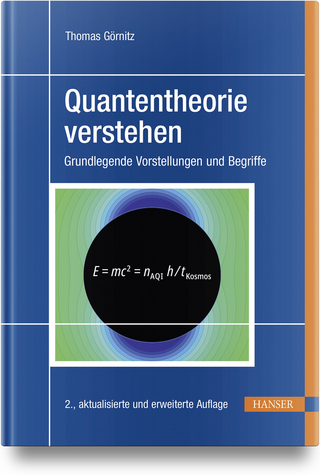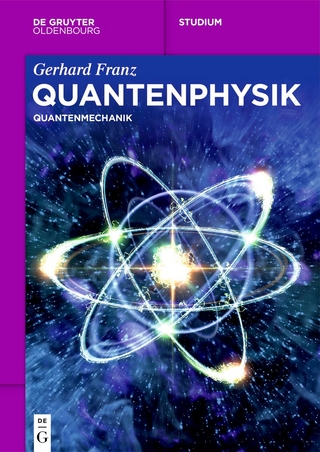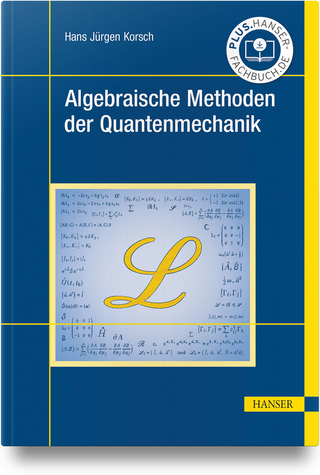
Time, Emergences and Communications
ISTE Ltd and John Wiley & Sons Inc (Verlag)
978-1-78630-250-2 (ISBN)
Introduction xi
Chapter 1. Quantum Physics and Information 1
1.1. Orthodox introduction to quantum physics 1
1.2. Quantum states or how nature communicates with physicists 6
1.3. Particles, information, evolution 10
1.4. Interpretation of Pauli’s exclusion principle 12
1.5. State vectors, science of orientations 14
1.6. Provisional conclusions on quantum mechanics 18
Chapter 2. Two Quantum Studies 21
2.1. Does the quantum universe observe us? 21
2.2. A detour by statistical mechanics 24
2.3. Expressive and receptive waves in quantum observation 25
2.4. Wave function fission 27
2.5. Form–energy duality in Schrödinger’s equation 29
2.5.1. Separation of spatial and temporal functions 29
2.5.2. Solution to the equation and quantum formalization of the hydrogen atom 31
2.5.3. Form–energy diagram and correspondences 32
2.5.4. Form and content in the quantum atom 33
Chapter 3. Quantum Entanglement 35
3.1. Some considerations on quantum entanglement 35
3.2. The mystery of quantum entanglement 37
3.3. Quantum entanglement and complex sciences: information and system 42
3.4. Concluding remark about strange information 45
Chapter 4. Quantum Darwinism and the Macroscopic World 47
4.1. Quantum Darwinism, from quantum to the observable world 47
4.2. The controversy between W. Zurek and R. Kastner 50
4.3. Understanding our classical perception with quantum physics, an anthropomorphic approach 53
4.4. From quantum substantial matter to spatiotemporal extension 56
Chapter 5. Chemistry and Quantum Communications 59
5.1. Brief epistemological notes 59
5.2. Chemistry, a little-known science that studies bondings and reactions 60
5.3. Orbitals and waves make bonding improbable 64
5.3.1. The electron takes part in the bond, but there is no bond 64
5.3.2. The molecule in question 66
5.4. Quantum bond, orbitals and monadological conception of chemistry 68
5.4.1. The theory of molecular orbitals in chemistry 68
5.4.2. Monadology, bonding and non-bonding orbitals 70
5.5. Molecular quantum communication 72
Chapter 6. Emergences in Matter 75
6.1. Introduction about emergence 75
6.2. The central conjecture in emergence theory 78
6.3. Physics, emergence ontology and communications 80
6.4. Quantum and information in the emergences of condensed matter 83
6.4.1. Material emergences and physical sciences 83
6.4.2. New horizons in the physics of condensed matter 85
6.4.3. Matter and information according to Xiao-Gang Wen 86
6.5. Tensor networks 89
6.5.1. The tools of statistical physics 89
6.5.2. The complicated invisible behind the visible 90
Chapter 7. Communication and Emergence Fields 95
7.1. Communication fields 95
7.1.1. Quantum communications 95
7.1.2. Morphogenetic field or communication field? 97
7.2. Are communication fields structured by quantum matter? 98
7.2.1. The field as a physical concept 98
7.2.2. The Lagrangian and the symmetries, main access door for studying fields as emergences 99
7.3. Is there a relation between quantified fields and emergences? 101
7.4. Brief overview of matter and emergences in contemporary physics 105
7.4.1. Dissipative structures 106
7.4.2. Condensed matter and exotic phases 107
7.4.3. Quantified fields or the emerging “material cosmos” 108
7.4.4. Exotic phases and the model with topology and entanglement 109
7.4.5. Overview, from Plotinus’ two categories of matter to quantum materiality 109
7.5. Philosophy and the physics of communicational emergence 110
7.6. Emergences and molecular communication in the living 111
7.7. Different considerations about language and the emergence of goal-oriented societies 114
7.7.1. Language, civilizations and human enterprises 115
7.7.2. The myth of Babel, communicating and building 116
7.7.3. Language structures 118
7.7.4. Language levels 120
7.8. Brief notes about the semantic field 121
Chapter 8. The Computer, from Physics to Biology 123
8.1. Computer and information in the 21st Century science 123
8.2. The research by David Deutsch and Seth Lloyd concerning the quantum calculator 125
8.3. Seth Lloyd and quantum order in the universe 128
8.4. Going beyond the theory of information: the resonance coupling principle 131
8.5. From the biological to the physical 132
8.5.1. From biology to informed physics: an original pathway offered by Paul Davies 133
8.5.2. Biology and networks: questioning emergence with information and entropy 134
8.5.3. Information and networks, theoretical limitations and metaphysical options 137
8.6. Kronos, Telos and the evolution of living emergences 138
Chapter 9. Time Philosophies: Kronos, Telos, Kosmos 141
9.1. Time is plural, as it is enigmatic 141
9.2. The “qualities” of time: an excursion through Eastern thought 144
9.3. Aristotle 147
9.4. Leibniz 149
9.5. Being, time, things 152
9.6. Things in modern science 155
9.7. Hegel, Nietzsche, Heidegger: three prophets of time 158
9.7.1. Hegel and the dialectic resolution of Kronos with Telos 159
9.7.2. Nietzsche and Kronos transmuted into Telos 160
9.7.3. Husserl, the world and Kosmos-based objects 161
9.7.4. Heidegger and the quest for Kosmos 162
9.7.5. Emerging Logos and Telos in the end times 164
Chapter 10. The Arrows of Time and Emergence 167
10.1. The three categories of time and contemporary physics 167
10.2. Noise, temperature, entropy, time arrow 170
10.3. The effect of temperature on emerging order 173
10.4. Order and the arrow of time 176
10.4.1. Entropy and disorder 176
10.4.2. Prigogine and irreversibility 178
10.5. From Kronos to Telos, irreversibility and the two arrows of material time 181
10.5.1. The RHS from the Brussels-Austin school 181
10.5.2. The two orientations of time and the metamorphosis of modern physics 184
10.5.3. The arrow of Kosmos; mechanics and thermodynamics 187
10.6. Kosmos, Kronos and Telos 188
10.7. Concluding remark on physics and things 191
10.8. From the history of black holes to the light of time 193
Chapter 11. Mesoscopic and Macroscopic 199
11.1. Between infrascopic and macroscopic quantum, the mesoscopic order 199
11.2. Horizontal and vertical emergences 202
11.3. The signals associated with emergences 204
11.3.1. Infrascopic fundamental matter and quantum interactions 205
11.3.2. Condensed matter and mesophysical emergences 205
11.3.3. Molecular matter 206
11.3.4. Life at the mesoscopic level 206
11.3.5. Macrobiology and macroscopic emergences 208
11.3.6. Human societies and communicating forms 210
11.3.7. Ordering and interpreting systems in human emergences 211
11.4. Biosemiotics, emergences and evolution 212
11.5. Physicalism and mental processes 217
11.6. Some considerations on emergent worlds 219
11.6.1. Gravity, AdS/CFT, megascopic emergence cosmos 219
11.6.2. The emergence of the sacred and Being 221
11.7. The order of time at the four scales of the universe 222
Chapter 12. Epilogue on Forthcoming Science 225
12.1. Modernity is achieved 225
12.2. Unfinished notes on the cosmos, physics and metaphysics 228
12.3. Communicational emergences represented in a figure 230
12.4. The metamorphosis of the subject 231
12.5. From Kosmos to Logos 232
12.6. Epilogue on three ongoing scientific revolutions 233
Conclusion 237
Bibliography 241
Index 245
| Erscheinungsdatum | 03.05.2018 |
|---|---|
| Verlagsort | London |
| Sprache | englisch |
| Maße | 163 x 239 mm |
| Gewicht | 535 g |
| Themenwelt | Naturwissenschaften ► Physik / Astronomie ► Quantenphysik |
| ISBN-10 | 1-78630-250-0 / 1786302500 |
| ISBN-13 | 978-1-78630-250-2 / 9781786302502 |
| Zustand | Neuware |
| Informationen gemäß Produktsicherheitsverordnung (GPSR) | |
| Haben Sie eine Frage zum Produkt? |
aus dem Bereich


